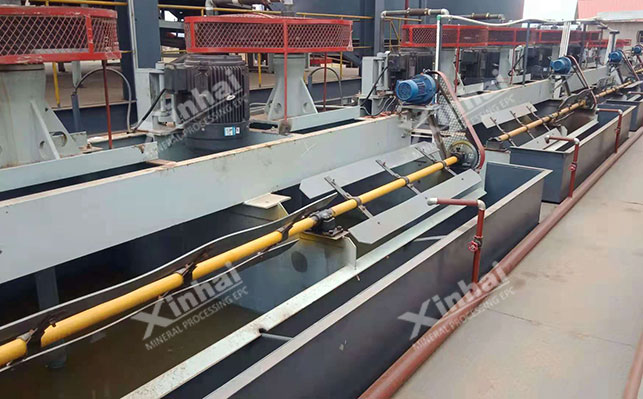
15311826613
Click to add WeChatBarite (BaSO4) is an important non-metallic mineral resource with a high density, usually presenting as white or colorless crystals. It is used in oil drilling, chemical industry, medicine and other fields. This article will introduce in detail the commonly used barite beneficiation methods, as well as the workflow from raw materials to finished products.
Barite beneficiation mainly involves separating the useful component barite from large ore blocks (also known as purification). Common beneficiation methods include gravity separation, flotation, magnetic separation and chemical treatment, etc.
Baryte gravity separation method: It uses the density difference between barite and gangue minerals for separation. The most common ones are jigging separation, shaking table separation and spiral chute separation. Among them, jigging separation uses periodic up and down pulsating water flow to separate the materials according to density and discharge them separately. It has a better effect on coarse and medium-sized barite separation; shaking table separation is to separate the ore particles on the bed by the combined effect of water flow flushing and differential movement of the bed surface. It is suitable for processing fine-grained barite; spiral chute separation is to let the slurry rotate in the spiral trough. Under the action of gravity, centrifugal force and friction, the ore particles of different densities move along different trajectories of the spiral trough and are separated.

Baryte flotation method: is to make the mineral surface hydrophobic by adding mineral processing reagents, and then attach to the bubbles and float up to complete the separation of gangue and barite. Direct flotation or reverse flotation is commonly used. Among them, direct flotation mostly uses fatty acids as collectors to float barite, and uses sodium silicate to suppress gangue minerals such as fluorite, quartz and calcite, and recovers barite under weak alkaline conditions (pH8-9); reverse flotation is to first float gangue minerals (or other useful minerals) to suppress barite, and the tailings obtained are barite concentrate. When there are fine-grained silicate minerals, calcite, quartz and other gangue minerals in the selected ore, reverse flotation can effectively remove the fine-grained gangue minerals and obtain high-quality barite concentrate.

Barite magnetic separation method: Usually, when barite minerals contain magnetic impurities, magnetic separation can be used to remove them first. There are two types: dry magnetic separation and wet magnetic separation. Among them, dry magnetic separation is mostly suitable for processing materials with coarse particles and low water content. In the air medium, magnetic and mechanical forces are used to separate the materials; wet magnetic separation is suitable for processing fine-grained materials or materials with high water content, and magnetic separation is carried out in water or other liquid media.
Chemical treatment of barite: When other methods cannot obtain the ideal recovery rate, chemical methods can be used to remove colored impurities in barite. There are two methods: roasting and leaching. Among them, leaching purification uses acid or alkali solution to react with metals or metal oxides attached to the surface of the mineral to generate soluble substances for separation; calcination purification removes impurities through high-temperature volatilization to improve purity and whiteness.
Barite ore cannot be used for industrial applications. Barite concentrate needs to be extracted from it. So what is the workflow from raw materials to finished products? The following is a detailed workflow:
Crushing: is to crush the large ore blocks after mining. Jaw crusher or Cone crusher is often used to perform coarse and fine crushing operations to reduce the ore particle size to increase the degree of dissociation between minerals.
Grinding: is to grind the crushed ore particles in one step to achieve the state of monomer dissociation. The equipment required for this stage is mainly a ball mill or rod mill. The process is equipped with a cyclone as a classification equipment to classify the ore particles after ball milling, so that qualified materials can enter the next stage, and unqualified materials are returned to the ball mill for re-grinding.

Separation: It is the above-mentioned gravity separation, flotation, magnetic separation and chemical separation methods. After fine grinding, it reaches the monomer dissociation state. Several methods are used to effectively separate the gangue minerals from the barite to obtain high-grade barite concentrate.
Concentration and dehydration: After sorting, barite concentrate is mostly in a slurry state. If you want to enter the subsequent operation, you need to concentrate and dehydrate it. Usually, you can use high-efficiency concentrator+filter press for processing, or directly use the concentrator to dehydrate.

As an important non-metallic mineral resource, the mineral processing process of barite is of great significance to improving resource utilization and ensuring product quality. Through scientific process design and strict quality control, the processing efficiency of barite can be effectively improved to meet the needs of different industrial fields. Xinhai Mining has more than 20 years of experience in barite beneficiation. We can conduct beneficiation test analysis, and then design a reasonable barite beneficiation process according to the actual ore properties. At the same time, we can provide a complete set of beneficiation equipment solutions. If you have any needs, please feel free to consult.